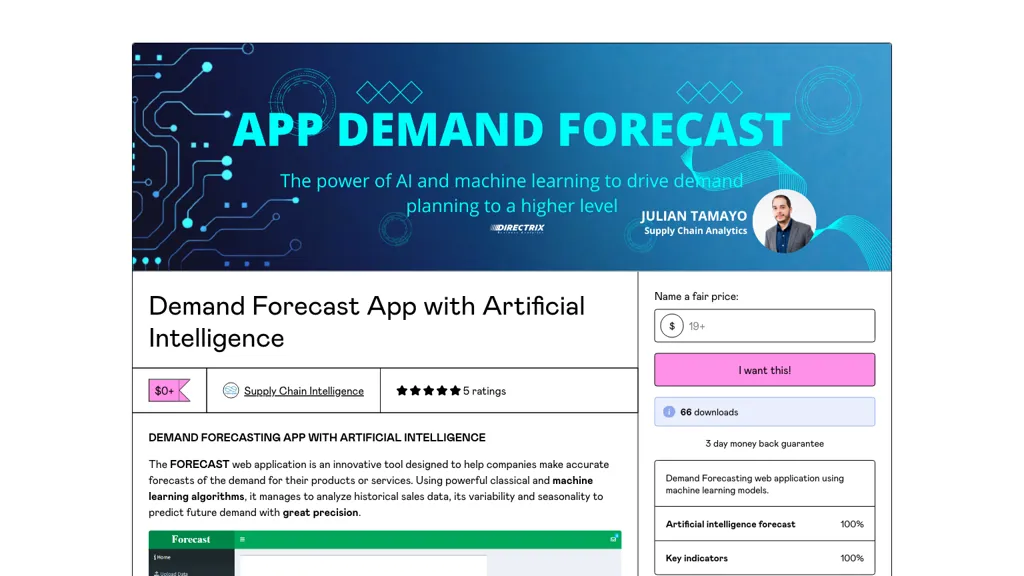What is Demand Forecast?
Demand Forecast is the most advanced, AI-driven web application to help businesses in making accurate forecasts of demand regarding sales of products and services. It uses classical, robust machine-learning algorithms to analyze historical data on sales that predict future demand with extreme accuracy, accounting for variability and seasonality.
Users can easily upload datasets from Excel and select an estimated model, such as ETS, ARIMA, Prophet, Random Forest, and SVM. Based on the selected one, its advanced algorithm chooses the best model for each product. Also, it provides clear visualizations and interactive graphs for the demand forecast over time. This enables a firm to plan well in advance within its production, inventory, and supply chain to enhance efficiency and reduce operation expenditures.
Key Features & Benefits of Demand Forecasting
Demand Forecast is rich in features and benefits that best suit various users. These include:
-
Classic Machine Learning Algorithms:
Equipped with robust algorithms that treat historical sales data. -
Data Upload:
It enables a simple upload of data sets from Excel. -
Model Selection:
Automatically chooses the best model for each product. -
Visualizations:
Clear out visualizations with interactive graphs for the demand forecasts. -
Advanced Features:
It will have trend data analysis, outlier detection algorithms, model competition algorithms, and KPI forecast systems.
A business can make better decisions, utilise available resources optimally, and perform better compared with peers in competitive markets with this.
Use cases and applications of Demand Forecast
Demand Forecast is related to various use cases that acquire accurate demand forecasts of different products and services:
-
Production Planning:
The company is able to understand, with a high degree of accuracy, the demand trends in the future so that production can be scheduled in an effective way. It also aids management in inventory management because the required level of inventory to be maintained at any point of time can be planned to attain operational efficiency and cut costs. -
Model Selection:
Automatically selecting the best forecasting model based on uploaded datasets helps in easy decision making. This application is embedded with advanced features related to outlier detection and imputation and hence is quite useful in detecting anomalies in the sale patterns. -
Performance Evaluation:
Define KPIs, used in the measurement of the forecast’s reliability, therefore allowing data-driven strategies that push toward business growth.
How to Use Demand Forecast
Utilizing Demand Forecast is unexpectedly straightforward and user-friendly. To begin, proceed as follows:
-
Upload Historical Data:
You can start by importing your company’s sales history from Excel into the platform. -
Choose a Model:
For each product, the app automatically chooses the most adequate forecasting model, based on the imported data. -
Visualizations:
See the clear visualizations and interactive graphs helping in demand prediction. -
Decision-Making:
Upon gaining the insights, use them in making definitive decisions relating to production, inventory, and supply chain.
Tips and Best Practices:
Make sure you update your historical data at frequent intervals. Use outlier detection to clean your data, and review the KPIs for knowing that the forecast is reliable.
How Demand Forecast Works
Demand Forecast operates on an advanced technical bedrock that weaves in classical machine learning algorithms against the analysis of historic sales data, thus:
-
Algorithms:
Accomplishes demand forecasting using ETS, ARIMA, Prophet, Random Forest, and SVM models. -
Model Selection:
It automatically picks the best data model for each product, depending on the characteristics of the data. -
Workflow:
It’s a continuous loop from data upload, through model selection, visualization of predictions, and performance refinement based on KPIs.
Pros and Cons of Demand Forecast
This demand forecast tool, like all other tools, comes with the benefits and probable flaws. The advantages comprised high precision of demand forecast, ease in interface use, auto-selection of models, advanced features that made it easier to analyze data, and provide clear visual aids. The possible flaws consist of probably requiring initial cleaning of data, only as good as the historical data used, and it is dependent on how well the selected models work. Customer feedback for this tool has been mostly positive, stating that it’s user-friendly and highly accurate in its predictions.
Demand Forecasting FAQs
-
Q: How accurate are Demand Forecasts?
A: As accurate as the historical data it’s based on and how well the chosen models fit. Demand Forecast uses advanced algorithms that allow accuracy. -
Q: What data sources does Demand Forecast support?
A: Currently, Demand Forecast supports data uploads from Excel. For other data sources, you might need to convert them into a compatible source file type. -
Q: How often should I update my historical data?
A: Practicing regular and frequent updates of your historical data is one way to give updates to the forecast, making the forecast as accurate and dependable as possible. -
Q: What industries does Demand Forecast apply to?
A: Demand Forecast will serve industries such as retail, manufacturing, and supply chain management that require high precision in demand forecasting. -
Q: Do you have setup fees?
A: For specific pricing and setup fees, it is ideal to reach out directly to the Demand Forecast sales team.










